To visit - Fez
Fès, also spelled Fez, is a city located in northern inland Morocco. It is one of the country's oldest and most historic cities, known for its well-preserved medieval architecture and vibrant cultural heritage. Here are some key points about Fès:
-
Historical Significance: Fès is renowned for its rich history and is considered one of Morocco's four imperial cities, along with Marrakech, Meknes, and Rabat. The city has been a center of political, cultural, and religious importance throughout its long history.
-
Medina of Fès: The heart of Fès is the UNESCO World Heritage-listed Medina (old city), which is one of the world's largest car-free urban areas. The Medina of Fès is a labyrinth of narrow, winding streets, bustling markets, and historic buildings.
-
Al-Qarawiyyin University: Founded in 859 AD, Al-Qarawiyyin University in Fès is considered the oldest continuously operating educational institution in the world according to the Guinness World Records. It has played a significant role in Islamic scholarship and knowledge.
-
Historic Architecture: Fès is known for its well-preserved medieval architecture, including the Bou Inania Madrasa, the Al-Attarine Madrasa, and the tanneries where traditional leather goods are produced.
-
Craftsmanship and Markets: The city is famous for its traditional craftsmanship, including the production of ceramics, leather goods, textiles, and metalwork. The markets, or souks, in Fès offer a wide variety of goods and are a vibrant hub of activity.
-
Fès el-Bali and Fès el-Jdid: The old city is often divided into two main parts: Fès el-Bali (the old medina) and Fès el-Jdid (the new medina). Fès el-Bali is the historic core, while Fès el-Jdid was added in the 13th century.
-
Cultural Festivals: Fès hosts various cultural festivals, including the Fès Festival of World Sacred Music, which attracts artists and performers from around the world. The festival promotes intercultural dialogue and understanding through music and arts.
Visiting Fès provides a unique opportunity to experience the rich cultural heritage of Morocco and explore the winding streets and historical sites that have been part of the city's story for centuries.
The 8 essential things to do in Fez. :
Summary
1 - Medina of Fez el-Bali
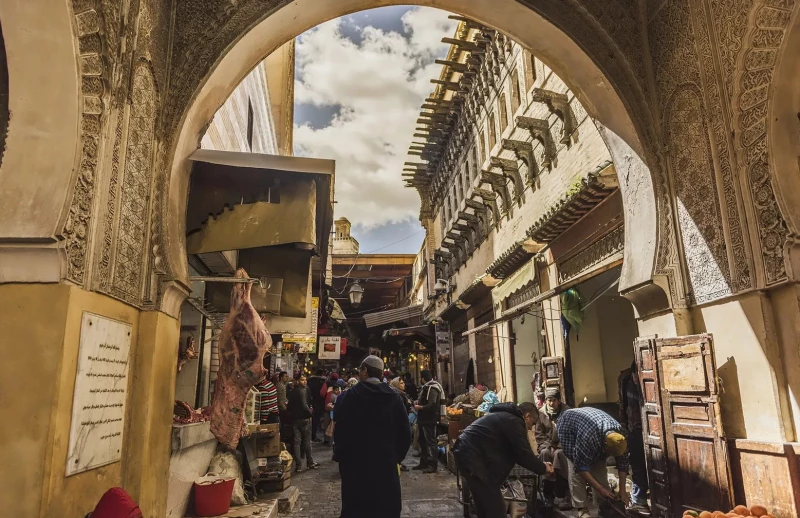
The Medina of Fès el-Bali is the historic heart of Fès and one of the best-preserved medieval medinas in the world. Here are some key points about this fascinating place:
-
UNESCO World Heritage Site: The Medina of Fès el-Bali was designated as a UNESCO World Heritage Site in 1981 due to its outstanding historical and architectural value.
-
Labyrinth of Alleys: The medina is a complex network of narrow alleys, winding paths, and covered passages. It's easy to get lost in this labyrinth, but it's also part of the adventure.
-
Souks and Markets: The medina's souks are renowned for their diversity. You'll find markets specializing in everything from spices and fabrics to leather goods, pottery, and artisanal products.
-
Bab Bou Jeloud: This monumental gate marks one of the main entrances to the medina. It is adorned with blue and green glazed tiles, creating an impressive entrance.
-
Mosques and Madrasas: The medina houses several historic mosques and remarkable madrasas (Quranic schools), including the Al-Qarawiyyin Mosque and the Bou Inania Madrasa.
-
Fondouks: These ancient caravanserais are historical buildings where traders stored their goods. Some have been restored and now house shops or artisan workshops.
-
Cafés and Traditional Restaurants: Explore traditional cafés and restaurants to taste Moroccan cuisine, including tagines and couscous. Some riads also offer meals in an authentic setting.
-
Fountains and Squares: The medina boasts numerous fountains and lively squares, such as Nejjarine Square, where you'll find the Nejjarine Fountain and the museum of the same name.
-
Artisan Workshops: Meet local artisans in their workshops, where you can witness the crafting process of handmade items such as carpets, pottery, and leather goods.
-
Nightlife: The medina takes on a special atmosphere at night. Some squares and alleys are illuminated, and it can be pleasant to stroll through the medina after sunset.
The Medina of Fès el-Bali offers an immersive experience into the history, culture, and daily life of Morocco, and every corner of this ancient city has something special to offer.
 Our tips for getting the most out of your experience.
Our tips for getting the most out of your experience.
Visiting the Medina of Fès el-Bali can be an extraordinary experience, but it can also be challenging due to its complexity and labyrinth of narrow streets. Here are some tips to make your visit more enjoyable and rewarding:
-
Hire a Guide: Hiring a local guide can greatly enhance your exploration of the medina. Guides know the alleys, local history, and can direct you to lesser-known but equally interesting sites.
-
Wear Comfortable Shoes: The medina's streets can be paved and uneven. Wear comfortable shoes to move around easily.
-
Study a Map: Before venturing out, take the time to study a map of the medina. This can give you an idea of the general layout and major points of interest.
-
Be Ready to Get Lost: Even with a map, it's easy to get lost in the narrow alleys. Be open to exploration and discovering new places.
-
Dress Respectfully: As the Medina of Fès is culturally rich, it's advisable to wear modest and culturally respectful clothing.
-
Avoid Peak Hours: The streets can get very crowded, especially in the early morning and late afternoon. Try to plan your visit outside of these peak hours if possible.
-
Taste Local Specialties: Take advantage of your visit to sample local specialties. Street food stalls often offer local culinary delights.
-
Negotiate at the Market: If you're shopping in the souks, remember to negotiate prices. Bargaining is an integral part of market culture in Morocco.
-
Respect Residents' Privacy: The medina is also a living space for its residents. Respect their privacy by avoiding intrusive photography or entering restricted areas.
-
Stay Hydrated: The narrow streets can get hot, especially in the summer. Make sure to stay hydrated by carrying a water bottle with you.
-
Learn a Few Arabic Words: While many locals speak French, learning a few words in Arabic, such as "salam" (peace) or "shukran" (thank you), can be appreciated.
By following these tips, you can fully enjoy your visit to the Medina of Fès el-Bali and explore the rich history and culture of this unique place.
2 - Leather tanners
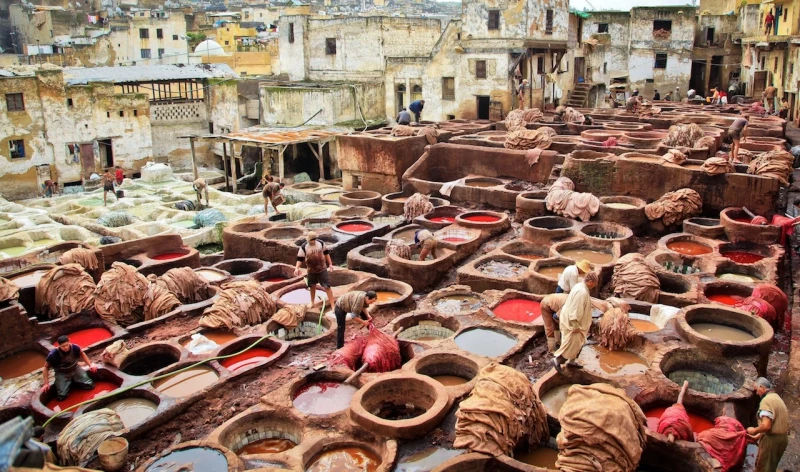
The leather tanneries in Fès are renowned for their traditional artisanal work, and visiting the tanneries is one of the iconic experiences in the city. Here is some information about the leather tanneries in Fès:
-
Location: The tanneries in Fès are primarily located within the Medina, and one of the most well-known tanneries is the Chouara Tannery. Tanneries are often clustered in specific areas where you can observe the leather processing.
-
Traditional Process: The Fès tanneries employ leatherworking methods that date back centuries. Raw leather is first cleaned, then soaked in vats filled with water and natural substances such as ammonia and pigeon droppings to soften and degrease the leather. Afterward, the leather is dyed using natural pigments.
-
Vibrant Colors: Fès tanneries are renowned for their brightly colored leathers. The dyeing vats often contain natural pigments such as saffron for yellow, paprika for red, and indigo for blue.
-
Observation from Terraces: To observe the process, you can access some of the terraces of nearby shops. The owners of these shops may provide you with mint leaves to hold against your nose to mitigate the strong smell of the tanning products.
-
Bargain for Leather Products: After observing the work of the tanners, you can explore nearby shops selling a variety of leather products, including bags, shoes, belts, and artisanal items. Don't forget to negotiate prices.
-
Wear Appropriate Clothing: Due to the strong odor of the tanning products, it's recommended to wear clothing that you aren't afraid to get dirty. A scarf or a nose mask can also be helpful.
-
Visit During Working Hours: The tanneries are generally open during working hours, so it's advisable to visit during the day.
A visit to the leather tanneries in Fès provides a fascinating insight into traditional craftsmanship and the cultural heritage of the city in the leather industry. However, be prepared for the strong smell associated with the tanning process.
 Our tips for getting the most out of your experience.
Our tips for getting the most out of your experience.
Visiting the leather tanneries in Fès can be a fascinating experience, but it requires some preparation. Here are some tips to make your visit more enjoyable and enriching:
-
Hire a Guide: Hiring a local guide can provide valuable insights into the leather tanning process, local history, and overall enhance your experience.
-
Wear Appropriate Clothing: The smells from the tanning products can be strong. Wear clothing that you don't mind getting dirty, and consider using a scarf or nose mask to mitigate the odors.
-
Visit in the Morning: Tanneries are often more active in the morning. Visiting early in the day allows you to observe the tanning process in full swing.
-
Ask for Mint Leaves: Before entering the terraces overlooking the tanneries, ask local vendors for mint leaves. Placing these leaves under your nose can help lessen the smell.
-
Negotiate with Caution: If you plan to buy leather products from merchants near the tanneries, be prepared to negotiate prices, but do so respectfully.
-
Be Ready to Explore: Tanneries are often integrated into labyrinths of alleyways. Be ready to venture and explore different parts of the area.
-
Respect Workers' Space: When on the terraces or near the tanneries, respect the workers' space. Avoid disturbing them while they are working.
-
Photograph with Care: Ask for permission before taking photos, especially of workers. Some may not be comfortable with photography.
-
Learn about the Process: Educate yourself about the leather tanning process before your visit. This will help you better understand what you are observing on-site.
-
Be Aware of Bargaining: If you plan to purchase leather items, be aware that bargaining is an integral part of market culture in Morocco.
By following these tips, you can fully enjoy your visit to the leather tanneries in Fès while respecting local culture and maximizing your experience.
3 - Al-Qarawiyyin University
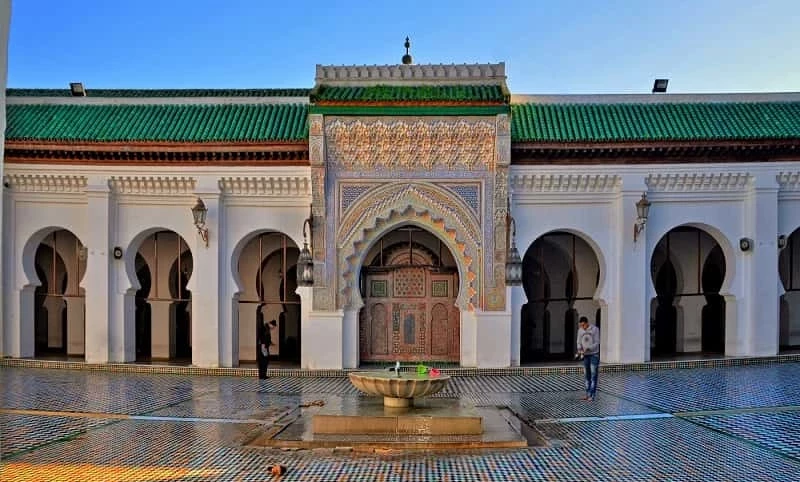
The University of Al-Qarawiyyin, located in Fès, Morocco, is considered the oldest continuously operating university in the world. Here are some key details about this historic institution:
-
Foundation: The University of Al-Qarawiyyin was founded in 859 by Fatima al-Fihri. It is one of the oldest universities globally, with a history spanning over a millennium.
-
UNESCO Status: Due to its historical significance, Al-Qarawiyyin was inscribed as a UNESCO World Heritage Site in 1981.
-
Faculties and Subjects: Al-Qarawiyyin offers teachings in various fields, including religious sciences, humanities, natural sciences, and social sciences. Emphasis is placed on Islamic studies, jurisprudence, Arabic grammar, medicine, and other disciplines.
-
Mosque and Madrasa: In addition to its educational activities, Al-Qarawiyyin houses a mosque and a madrasa (Quranic school). The mosque is open to worshipers for prayers, while the madrasa is where students receive their education.
-
Library: The university also houses an ancient library containing a collection of Islamic manuscripts and other valuable works. Some manuscripts in this library date back centuries.
-
Open to Non-Muslims: Historically, Al-Qarawiyyin was reserved for Muslim students, but in 2017, the university announced that it would be open to non-Muslims.
-
Restorations and Projects: Over the centuries, the university has undergone several renovations and restorations. Preservation projects have been undertaken to maintain its historical heritage.
-
Cultural and Historical Role: Al-Qarawiyyin has played a major role in preserving and transmitting Islamic knowledge and classical sciences over the centuries. It is an important cultural and historical symbol of Morocco.
If you are considering visiting Fès, the University of Al-Qarawiyyin is a must-visit historical site that provides insight into Morocco's educational and cultural history, as well as Islamic scholarship. Please note that access to certain parts of the university may be limited.
 Our tips for getting the most out of your experience.
Our tips for getting the most out of your experience.
Visiting the University of Al-Qarawiyyin in Fès can be a rewarding experience, but it requires some preparation. Here are some tips to make the most of your visit:
-
Respect Cultural Norms: The University of Al-Qarawiyyin is a sacred place of Islamic education. Ensure that you respect cultural and religious norms by wearing modest clothing and adopting a respectful demeanor.
-
Hire a Guide: Hiring a local guide can be beneficial for obtaining detailed information about the university's history, architecture, and cultural significance. Some guides may also facilitate access to specific areas.
-
Check Opening Hours: Make sure to know the university's opening hours. Opening hours may vary, and it's best to plan your visit accordingly.
-
Respect Restricted Areas: Some parts of the university may be reserved for students or religious activities. Respect restricted areas and follow provided guidelines.
-
Learn about the History: Before your visit, learn about the history of the University of Al-Qarawiyyin. Understanding its historical significance will enhance your experience.
-
Visit the Library: If possible, visit the university's library, which houses an impressive collection of ancient manuscripts. Respect rules regarding photography and interactions with the manuscripts.
-
Participate in Prayers: If you wish, you can participate in prayers at the university's mosque. Respect religious practices and avoid disrupting worshipers.
-
Negotiate Access to Terraces: Some parts of the university, such as terraces offering panoramic views, may require negotiation for access. If you are interested in these areas, discuss it with the on-site authorities.
-
Be Mindful of the Environment: Given the sacred nature of the place, be mindful of the environment. Avoid excessive noise and respect the tranquility of the surroundings.
-
Purchase Handcrafted Products: Take advantage of your visit to support local artisans by purchasing handcrafted products available near the university.
By following these tips, you can fully appreciate your visit to the University of Al-Qarawiyyin, immersing yourself in its rich history and contribution to culture and education.
4 - Bou Inania Madrasa
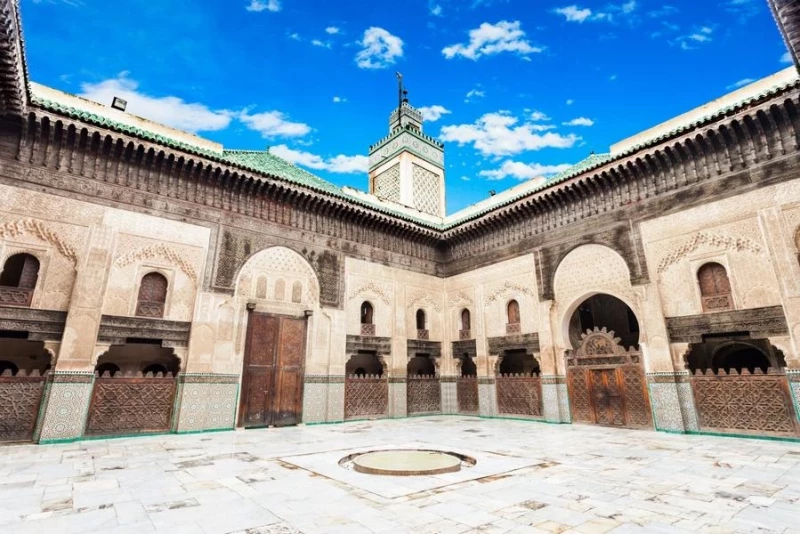
The Bou Inania Madrasa is a historic Islamic school located in the heart of the Medina of Fès, Morocco. Here are some key points about this remarkable architectural and educational institution:
-
History: The Bou Inania Madrasa was built in the mid-14th century, specifically in 1351-1356, during the Marinid dynasty. It was named after the ruling sultan, Abu Inan Faris, who commissioned its construction.
-
Architectural Beauty: The madrasa is celebrated for its exquisite architecture, showcasing the intricate details of Moroccan craftsmanship from the Marinid period. It is considered one of the finest examples of Merinid architecture in Fès.
-
Religious and Educational Role: Like many madrasas of its time, Bou Inania served both religious and educational purposes. It was a place for Quranic studies, Islamic law, theology, grammar, rhetoric, and astronomy.
-
Courtyard and Architecture: The madrasa features a central courtyard adorned with a stunning fountain and surrounded by galleries with intricately carved stucco, colorful zellij tiles, and cedar wood. The courtyard is a tranquil space for reflection.
-
Prayer Hall: Bou Inania Madrasa includes a prayer hall with a mihrab (prayer niche) that is considered a masterpiece of Islamic art. The mihrab is adorned with intricate geometric patterns and inscriptions from the Quran.
-
Minaret with a View: Unlike many madrasas, Bou Inania has a minaret, and visitors can climb to the top for a panoramic view of the historic Medina of Fès.
-
Cultural Heritage: The madrasa has been recognized as a UNESCO World Heritage Site, contributing to the preservation of Morocco's rich cultural and historical heritage.
-
Open to Visitors: Bou Inania Madrasa is open to visitors, allowing them to explore the beauty of Islamic architecture, learn about its historical significance, and experience the serene atmosphere of this educational institution.
When visiting Bou Inania Madrasa, be sure to check the opening hours and consider hiring a guide to provide insights into the history and architectural details of this splendid monument. It stands as a testament to the rich cultural and intellectual heritage of Fès.
 Our tips for getting the most out of your experience.
Our tips for getting the most out of your experience.
Visiting Bou Inania Madrasa in Fès can be a captivating experience. Here are some tips to make the most of your visit:
-
Opening Hours: Check the opening hours of Bou Inania Madrasa before planning your visit. Hours may vary, so make sure to arrive during the designated opening times.
-
Local Guide: Hiring a local guide can enhance your experience by providing detailed insights into the history, architecture, and cultural nuances of the Madrasa.
-
Appropriate Attire: As it is a religious site, it is recommended to wear modest clothing out of respect for the environment. Avoid clothing that is too short or revealing.
-
Photography: Make sure to be aware of the photography policy of the Madrasa. In some areas, photography may be limited or subject to specific rules.
-
Exploring the Courtyard: Take the time to explore the inner courtyard of the Madrasa. Admire the architectural details, the central fountain, and the artistic ornaments.
-
Observing the Mihrab: The prayer hall of the Madrasa houses a beautifully decorated mihrab. Take the time to observe it closely and appreciate the artistic details.
-
Climbing the Minaret: If the Madrasa has an accessible minaret, consider climbing to the top for a panoramic view of the Medina of Fès. This often provides a unique perspective.
-
Respecting the Space: Be respectful of the holy places and the religious nature of the Madrasa. Avoid disrupting prayers or religious activities that may be taking place.
-
Historical Insights: Familiarize yourself with the history of Bou Inania Madrasa before your visit. This will allow you to better appreciate the historical and cultural context.
-
Souvenir Shopping: If nearby shops or markets are available, consider buying artisanal souvenirs to support local craftsmen.
By following these tips, you can fully appreciate the architectural and cultural beauty of Bou Inania Madrasa in Fès while respecting its traditions and history.
5 - Batha Museum
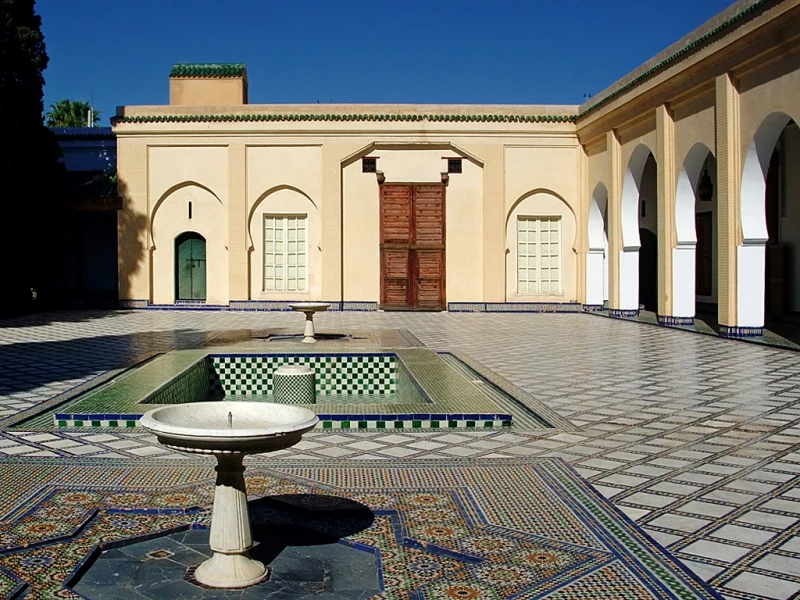
The Batha Museum, situated in the Batha district of the Medina of Fès, is a cultural gem nestled in the heart of Moroccan history. Housed in a 19th-century palace built by Sultan Moulay Hassan in 1897, this museum provides a captivating immersion into traditional Moroccan art. Its eclectic collections include textiles, pottery, jewelry, musical instruments, and weapons, showcasing the richness and diversity of the country's artisanal culture.
The architecture of the palace itself is a masterpiece of Hispano-Moorish design, with its intricate tilework, sculpted columns, and artistic details that transport visitors to a bygone era. Beyond the indoor exhibits, the Batha Museum features tranquil gardens where visitors can stroll and relax in a peaceful atmosphere.
The museum also offers an exceptional panoramic view of the Medina of Fès from its elevated position on a hill, providing a unique perspective on the ancient city. As a dynamic cultural venue, the Batha Museum occasionally hosts cultural events, temporary exhibitions, and artistic performances, reinforcing its role as a guardian of Morocco's cultural and artistic memory. Open to the public, it invites visitors to delve into the fascinating history of Fès and appreciate the exceptional artistic heritage of the kingdom. Before planning your visit, it is advisable to check the opening hours for an optimal experience.
 Our tips for getting the most out of your experience.
Our tips for getting the most out of your experience.
Visiting the Batha Museum in Fès can be a culturally enriching experience. Here are some tips to make the most of your visit:
-
Check Opening Hours: Before planning your visit, make sure to check the museum's opening hours. This will help you plan your day effectively.
-
Hire a Local Guide: Hiring a local guide can significantly enhance your experience by providing detailed information about the exhibits, the museum's history, and cultural anecdotes.
-
Respect Museum Rules: Ensure that you adhere to the museum's rules regarding photography, behavior, and the use of spaces. Some areas may have restrictions.
-
Explore the Gardens: Don't overlook the tranquil gardens of the museum. Take the time to stroll and enjoy the relaxing atmosphere while admiring the surrounding architecture.
-
Admire the Architecture: Take the time to appreciate the remarkable architecture of the palace. The Hispano-Moorish details, tiled work, and sculpted columns are worth exploring.
-
Discover the Collections: Explore the various collections of the museum, ranging from textiles to jewelry and pottery. Appreciate the diversity of Moroccan craftsmanship.
-
Enjoy the Panoramic View: Don't forget to climb to a higher point to enjoy the panoramic view of the Medina of Fès from the museum.
-
Inquire About Special Events: Check if the museum is hosting special events, temporary exhibitions, or artistic performances during your visit.
-
Purchase Souvenirs: If a souvenir shop is available, consider buying handmade souvenirs to support local artisans.
-
Take Your Time: Don't rush. Take the time to appreciate each exhibit, every corner of the museum, and immerse yourself in the cultural ambiance.
By following these tips, you can fully appreciate the Batha Museum and have a culturally rich and immersive experience in Fès.
6 - Tombs of the Marinids
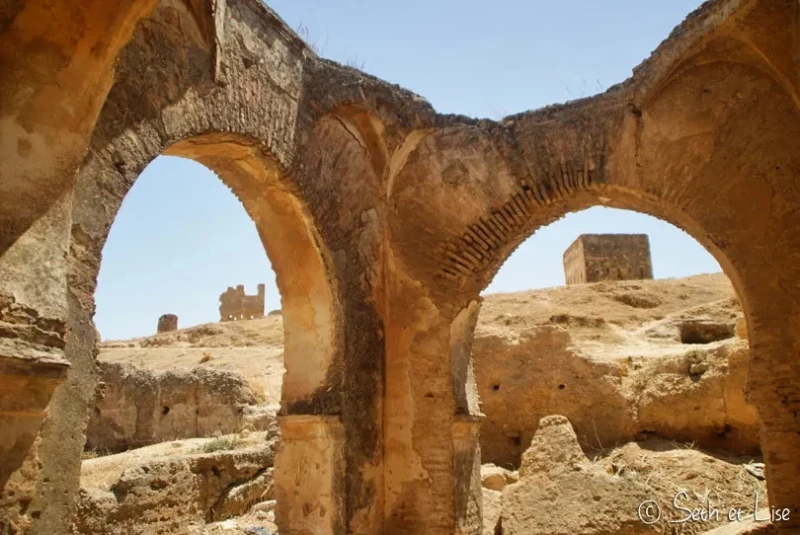
The Merinid Tombs, perched on the Zerhoun hill north of Fès, unveil the fascinating history of the Merinid dynasty that left its mark on Morocco between the 13th and 15th centuries. Constructed in the 14th century as a burial site, these tombs showcase distinctive Merinid architecture adorned with geometric patterns and calligraphic inscriptions. The mausoleums house the graves of prominent members of the dynasty, including Sultan Abu Inan Faris, revealing an artistic and architectural richness characteristic of Islamic art.
Providing a peaceful escape from the bustle of Fès' Medina, the site offers a contemplative atmosphere enhanced by the exceptional panoramic view of the city and surrounding mountains. The location, usually open to visitors, allows for an exploration of Merinid history in a picturesque setting.
The Merinid Tombs are also conducive to photography, although restrictions may apply to certain areas. Before planning your visit, it is advisable to check the opening hours to ensure a rewarding experience in this historically significant and tranquil location.
 Our tips for getting the most out of your experience.
Our tips for getting the most out of your experience.
Visiting the Merinid Tombs in Fès can be a unique cultural and historical experience. Here are some tips to make the most of your visit:
-
Opening Hours: Check the opening hours of the Merinid Tombs before your visit. Make sure you have enough time to explore the site.
-
Local Guide: Consider hiring a local guide to provide in-depth information about the history of the tombs, the Merinid dynasty, and architectural details.
-
Comfortable Shoes: Wear comfortable shoes as you may need to walk on uneven paths to fully explore the site.
-
Photography: Check the photography policy on-site. Some areas may have restrictions, so be sure to adhere to the rules in place.
-
Time of Day: Consider visiting the tombs at different times of the day. Morning or late afternoon may offer pleasant light for photography and a peaceful ambiance.
-
Bring Water: Ensure you have water with you, especially in warm weather. Exploring the site can be physical, and staying hydrated is essential.
-
Learn about the History: Before your visit, familiarize yourself with the history of the Merinid dynasty to better appreciate the historical context of the tombs.
-
Respect the Site: Be respectful towards the history and sacredness of the site. Avoid disrupting the tranquility of the area and respect any restricted zones.
-
Panoramic View: Take advantage of the exceptional panoramic view from the Merinid Tombs. It's an excellent opportunity to admire Fès and its surroundings.
-
Special Events: Check if there are any special events or cultural activities planned during your visit. This can add an extra dimension to your experience.
By following these tips, you can fully appreciate the Merinid Tombs, exploring the rich history and architectural beauty of this historical site in Fès.
7 - Royal Palace of Fez
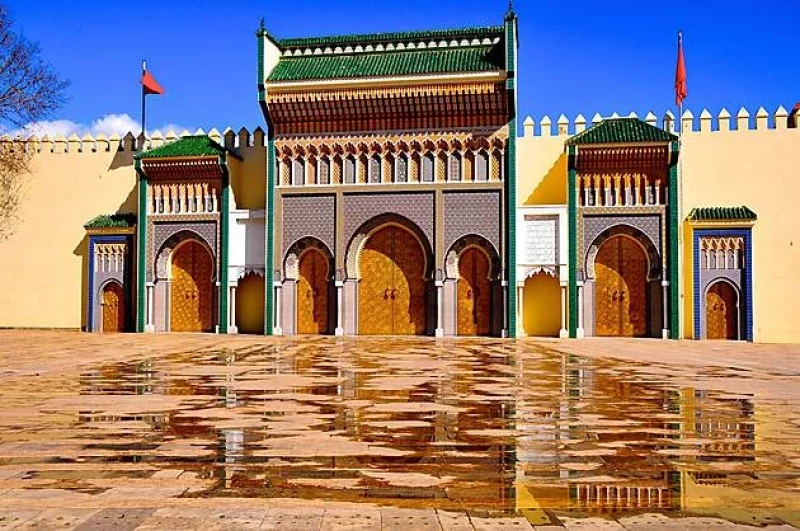
The Royal Palace of Fès, also known as Dar el-Makhzen, stands at the heart of the Medina, forming a jewel of Hispano-Moorish architecture in Morocco. Built in the early 20th century under the reign of Sultan Moulay Youssef and later expanded by Sultan Mohammed V, the palace showcases refined Moroccan craftsmanship. Its monumental brass doors, adorned with traditional patterns, welcome visitors into a world of royal splendor.
Inside, lush gardens, elegant inner courtyards, and artistically crafted fountains create a serene atmosphere. Architectural details like zelliges, intricately carved plaster, and richly decorated cedarwood add to the magnificence of the place. While some parts of the palace are reserved for the private use of the royal family, the spaces accessible to the public reveal a remarkable cultural and architectural richness.
As a royal residence during the visits of the royal family to Fès, the Royal Palace remains a symbol of Moroccan history and its artistic heritage. While photography may be limited in some areas, exploring this iconic site offers immersion into the grandeur and majesty of Morocco. Visitors are encouraged to respect the rules and appreciate the beauty of the Royal Palace with decorum.
 Our tips for getting the most out of your experience.
Our tips for getting the most out of your experience.
Visiting the Royal Palace of Fès can be a fascinating cultural and historical experience. Here are some tips to make the most of your visit:
-
Check Opening Hours: Before planning your visit, make sure to check the opening hours of the Royal Palace. Some parts may be closed to the public at specific times.
-
Respect Decent Attire: As the Royal Palace is a place of dignity and respect, dress appropriately, avoiding overly casual clothing.
-
Hire a Local Guide: To gain in-depth information about the history, architecture, and culture associated with the palace, consider hiring a local guide.
-
Photography: Respect the photography rules in place. Some areas may have restrictions, especially those reserved for the private use of the royal family.
-
Explore the Gardens: The gardens of the Royal Palace are often beautifully landscaped. Take the time to explore them to appreciate the tranquility and beauty of the landscape.
-
Learn about the History: Before your visit, educate yourself about the history of the Royal Palace and the Moroccan dynasty to better understand the cultural richness of the site.
-
Respect Visiting Rules: Be attentive to specific rules of the Royal Palace regarding visits. Certain areas may be restricted or off-limits to visitors.
-
Be Aware of Current Use: Keep in mind that the Royal Palace is still used as a residence by the royal family during their visits to Fès, so be respectful of their privacy.
-
Appreciate Architectural Details: Take the time to admire the exquisite architectural details of the palace, including zelliges, sculptures, and monumental doors.
-
Be Respectful: In general, be respectful towards Moroccan history and culture. Avoid disturbing the tranquility of the place and follow the guidance of the staff.
By following these tips, you can fully appreciate the visit to the Royal Palace of Fès, a place rich in history, remarkable architecture, and Moroccan culture.
8 - Jnan Sbil Garden
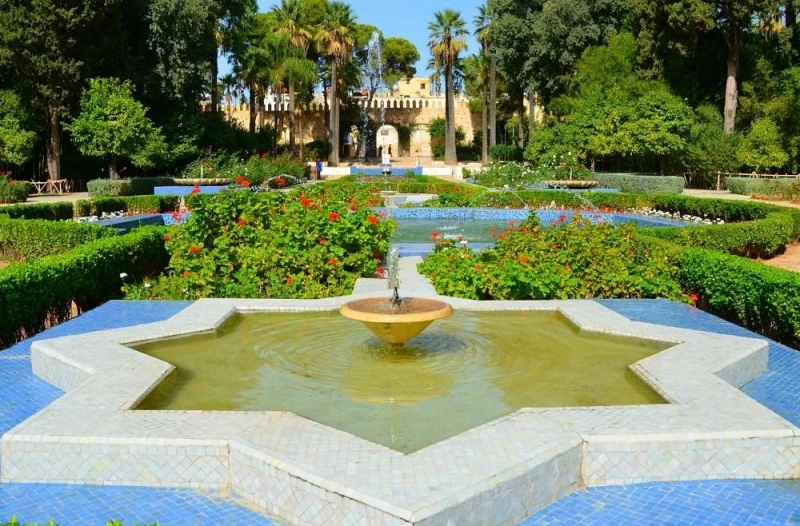
Jnan Sbil Garden, nestled near the Medina of Fès, provides a picturesque escape in the heart of the city. Originally designed in the 19th century by Sultan Moulay Hassan I, the garden features shaded walkways, water basins, and lush vegetation in the style of traditional Andalusian gardens. Visitors can stroll among a variety of colorful plants and flowers, capturing the serenity of the environment.
Traditional architectural elements, such as pavilions and statues, add an aesthetic touch to the garden. Often the venue for cultural events, concerts, and exhibitions, Jnan Sbil Garden offers a dynamic atmosphere within Fès. With free access, it is a popular spot for locals and visitors seeking relaxation. Opening hours may vary, but generally, the garden provides an ideal space for outdoor activities, reinforcing its status as a verdant haven in the heart of the historic city.
 Our tips for getting the most out of your experience.
Our tips for getting the most out of your experience.
Visiting Jnan Sbil Garden in Fès can be a delightful and relaxing experience. Here are some tips to make the most of your visit:
-
Ideal Timing: Visit the garden early in the morning or late in the afternoon to avoid intense heat and enjoy softer lighting for photography.
-
Appropriate Clothing: Wear light and comfortable clothing, especially if you're visiting during the warmer months. Don't forget to bring a hat and sunscreen.
-
Local Guides: If possible, hire a local guide to gain in-depth insights into the history of the garden, its design, and the plants that inhabit it.
-
Photography: Capture the beauty of the garden, but be respectful to other visitors and maintain the tranquility of the place. Some areas may have photography restrictions.
-
Relax: Take time to relax. The garden provides numerous shaded benches where you can sit, read a book, or simply enjoy nature.
-
Explore All Sections: Don't limit yourself to one part of the garden. Explore all sections to discover different plants, fountains, and architectural elements.
-
Special Events: Check if there are any special events or cultural activities scheduled during your visit. This could add a unique dimension to your experience.
-
Respect the Environment: Be respectful of the vegetation and environment. Avoid walking on flower beds and adhere to the garden rules.
-
Learn about the History: Familiarize yourself with the history of the garden before your visit to better appreciate its cultural significance.
-
Bring Water: Make sure to have water with you, especially in warm weather. Stay hydrated throughout your exploration.
By following these tips, you can fully appreciate the beauty and tranquility of Jnan Sbil Garden in Fès, providing a peaceful break amidst the hustle and bustle of the city.
Fez - Where to Stay?
In Fès, you have various accommodation options depending on your preferences and budget. Here are some suggestions for different types of accommodation in Fès:
-
Medina of Fès: If you want an authentic experience and be in the heart of the action, consider staying in a riad within the Medina. Riads are traditional Moroccan houses renovated to offer an intimate atmosphere and are often tastefully decorated.
-
Medina Hotels: There are also hotels located within the Medina, offering a blend of modern comfort and traditional ambiance. Make sure to check reviews and amenities provided by each hotel.
-
Hotels Outside the Medina: If you prefer a quieter environment, you can choose to stay outside the Medina. Fès has many hotels of various categories located outside the old town.
-
Palaces and Charming Residences: Some historic palaces and residences have been transformed into luxury accommodations in Fès. These establishments often offer a unique and upscale experience in a historical setting.
-
International Chain Hotels: If you prefer international hotel chains, Fès also has options from well-known hotel brands.
-
Tourist Residences: For longer stays or group travel, you might consider a tourist residence, which often provides kitchen facilities and more space.
Before booking, make sure to check online reviews, rates, and amenities offered by the establishments to choose the one that best suits your needs and preferences.
Fez - How to get around?
In Fès, there are several transportation options for getting around the city. Here are some common ones:
-
On Foot: The medina of Fès is a labyrinth of narrow streets, and the best way to experience its charm is by walking. This allows you to explore markets, historical sites, and neighborhoods in greater detail.
-
Taxis: Taxis are widely available in Fès. You can hail a taxi on the street or find them at designated taxi stands. Make sure the driver uses the meter, or agree on the fare before starting your journey.
-
Horse-Drawn Carriages (Caleches): For a more picturesque experience, you can opt for a horse-drawn carriage, known as a "caleche." These carriages offer leisurely rides through the city.
-
Buses: Fès has a public transportation network, including buses, serving different parts of the city. Fares are usually affordable, but schedules may vary.
-
Car Rental: If you want to explore the surroundings of Fès or have more flexibility in your travels, car rental is an option. Make sure to be familiar with local driving rules and follow traffic signals.
-
Bicycles: For cycling enthusiasts, some areas of Fès are suitable for biking. You can rent a bicycle in certain parts of the city.
-
Shared Vehicles: Ride-hailing services and carpooling apps may also be available in Fès.
Before choosing your mode of transportation, consider the distance to be covered, your budget, and personal preferences. Each mode of transport has its advantages depending on the situation and your specific needs in Fès.
Fez - Best period
The best time to visit Fès depends on your preferences regarding climate and activities. Here is some information to help you choose the ideal time for your visit:
-
Spring (March to May): Spring is often considered one of the best seasons to visit Fès. The temperatures are pleasant, with sunny days and cool nights. Gardens are in bloom, and it's an ideal time to explore the medina and participate in cultural festivals.
-
Fall (September to November): Similar to spring, fall offers moderate temperatures, and the city is less crowded with tourists compared to the summer peak season. It's also a good time for exploring Fès in pleasant weather.
-
Summer (June to August): The summer months in Fès can be hot, with temperatures often exceeding 30 degrees Celsius. It is the peak tourist season, but if you can tolerate the heat, it's also when festivals, cultural events, and outdoor activities are abundant.
-
Winter (December to February): Winters in Fès are generally mild during the day, but nights can be cool. There may be occasional rainfall. Winter temperatures attract fewer visitors, making it a good time if you prefer a quieter experience.
It's important to note that seasons can vary from year to year, and it's always recommended to check specific weather conditions for your travel period. Festivals, cultural events, and accommodation availability can also influence the choice of the visiting period.

